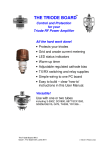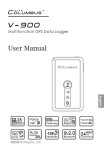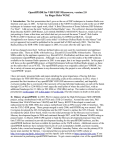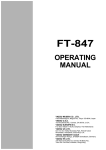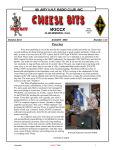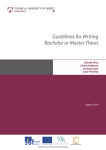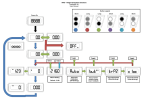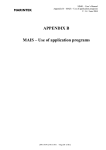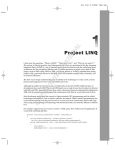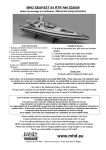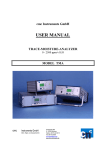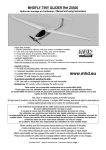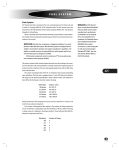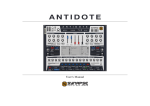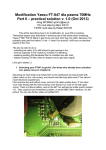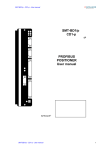Download conference paper
Transcript
QRM in VHF Contests Vladimír Petržílka, OK1VPZ www.ok2kkw.com presentation prepared for Polish VHF meeting in Zieleniec 2014 poor English translation made by author Why to talk about VHF contesting? What consequence it have.. - Funny for participants and even a bit of adrenalin (OK, why not..) - More activity on VHF bands and even few DX QSOs. And testing your gear… ------- And what about: be ensured, that I’m better, than competitor, or event the best!? THE BEST?.... TAKE CARE! => It is already more about PSYCHOLOGY! - - Operator‘s EGO empowering through conquery of rival station in contest result?! - - However nobody will winn always! Is you result worse, than expexted? Envy to competitor may bring decision to use unlegal tools (RF power, or even remote RX…) And it may create QRM, which fall off human relations. Where is a Hamspirit today? We have in OK operators, who – when they did not won a twice in VHF Contest – stop all VHF activity. Really it was a spoil for QRM only? - If you can not be on second position in VHF contest, maybe just three other basic options are: to be always the first in EME contesting (or with first QSOs abroad), or even win always in SHF contest on super microwaves (above 100GHz).... .... Or to learn what you can to improve and stay human.... Contesting on VHF bands is fun and it is a satisfaction for all of life. If you haven’t EGO hypertrofy, I would suggest never be a surrender and learn, how to be better and what you make to improve for next. And to have a bit of mercy for other, who feels, that he must be always the best... And now few words about QRM Commercial products like a ICOM, YAESU, KENWOOD, ELECRAFT, TEN TEC, or even MIRAGE, BEKO etc. is not a professional equipment! Due to it would be quite helpful to know a bit more about limits of your equipment, used in VHF Contests, than you may read in user manual... QRM in contesting and EMC generally is quite complex issue. You never know, what may happen in contest, where strong RF field may have some influence. So you need not only knowledge but humility as well. EGO hypertrofy is not a good advisor! Did you listen on VHF bands during Contest just other stations and noise? • Video QRM • https://www.youtube.com/watch?v=IgNncmA3RN0 • https://www.youtube.com/watch?v=qbpPFezx8GM • https://www.youtube.com/watch?v=bZaC8eOewjY • Why we present Czech experience? • Compare for example: 3rd. subregional 144MHz Contest 2014: • Poland – 66 stations – 313000km2 – neighbours distance avg. 78km • Czech – 157 stations – 79000km2 – neighbours distance avg. 25km only! What is a main reason of QRM: • Operators faults • Intermodulation of transmitter chain • Sideband noise of local oscilators in both TX & RX gear • Rough and unusual failures • Troubles on RX side • System troubles Operators faults - - overdrived PA - particularly SSPA – PEP measurment of PWR is missing! - http://www.ok2kkw.com/00003016/wattmetr/wattmeter_2_cz.htm - (or use at least LED bargraf with LM3914 IC! Or similar, to see the peaks!) - transceiver ALC loop malfunction http://lea.hamradio.si/~s53rm/IC275H.htm http://www.sm5bsz.com/dynrange/eme2004/eme2004.htm disable ALC, or modify time response of ALC loop: http://www.ok2kkw.com/00000104/ft847_alc_mod/alc_ft847_cz_2.htm (or at least decrease in transceiver SW gain of TX chain!) - break down of supply voltage for transceiver in case of use battery supply, - unskilled operator, who has no VHF QRM experience (on HF it is different!) - broadband noise of TX chain – bad system design of TX way – too many amplifiers in cascade are working with too low signal level Intermodulations • Sometime on nonlinearities of active elements may be created new frequencies, which could be a QRM reason: Transmitter intermodulations • - low voltage SSPAs – short linear response in case of 12V supply (linearity troubles with Mitsubishi hybrids), bad BIAS circuit for AB class http://www.ok2kkw.com/00003016/bias/bias_new.htm http://www.ok2kkw.com/zdroj_predpeti_elektronky.htm http://www.ok1baf.wz.cz/g2/g2.htm - bad input matching of tube PA, connected to SSPA output + even positive feedback of triode PA with common grid (mostly on 70cm) http://www.ok2kkw.com/studnice/gi7b_neutralization.htm - bad matching on SSPA output – may create even malfunction of ALC - intermodulation of driver transceiver (for example FT1000) in case of use transverter low level output due to disconnected ALC in TRX. Phase (sideband) noise of TX & RX Local oscillators - Calculate path loss between two contest stations in 25km distance http://en.wikipedia.org/wiki/Free-space_path_loss http://www.qsl.net/pa2ohh/jsffield.htm Phase (sideband) noise of TX & RX Local oscillators - comparison of regular used transceivers and why the HF TRX with transverter has better performance http://www.sm5bsz.com/dynrange/eme2004/eme2004.htm http://www.df9ic.de/tech/trxtest/trxtest.html http://www.df9ic.de/tech/trxtest/trxtest.html • Note: sideband noise level is ordinary presented in dBc/Hz (1Hz wide band), but in practice is used SSB filter 2,5kHz. In SSB case the sideband noise level is higher by 34dB! What about some improvement? X.O. by DC8RI! http://www.ok2kkw.com/00000104/preselector/rmc/krystalove_oscilatory_sideband_noise.htm And what about insert some X-tal filter into TX & RX IF chain? How to find a way to improvement? Look here! http://www.ok2kkw.com/next/sideband_noise_ft5000mp.htm http://www.ok2kkw.com/next/staronove_vyzvy.htm http://www.ok2kkw.com/00000104/preselector/preselect_quarz_filter.htm How to recognize different kind of QRMs? Bad intermodulation in transmitter: - very bad QRM in case of SSB - slightly better when CW is used - better if QRG distance is higher Sideband (phase) noise of L.O. : - worst in case of CW - better in case of SSB - better if QRG distance is higher Broadband noise of transmitter chain: - broadband noise does not related to a modulation - does not comply with QRG gap Corona RF arc: similar to sideband noise, but the same for SSB & CW RF ingress: variable by TX stand constellation - for example antenna beaming Bad switching PS and other reasons: create spurious modulated by transmitter Clicks in case of CW, and many more… Very often are combined two or even more QRM reasons.. Rough and unusual QRM sources - - RF ingress from your own antenna, or from near commercial transmitter (FM, TV, KV): - - into modulation, PLL, power supply regulation, other supportive circuits… - switching PS for PA a TRX: operational frequency around 60 kHz: - creates birdies & spurios – additional filtration is needed, use just HQ PS!. http://www.ok2kkw.com/00003016/pa70cm/im008884.jpg - another QRM source: diffused magnetic field from PS, PC, second transceiver with the same IF, RF Corona arc in the cavity of tube PA, and particularly: any bad PWR connection - for example not well tighten screw in AC wall socket… Troubles on receiver side - check intermodulation robustness of complete RX chain incl. LNA - why the LNA with high IMD performance is so needed? Particularly due to Out of band interference! The whole RX chain would be fatefully overloaded by signals far away from reception band - even by signals hundred MHz away! http://www.ok2kkw.com/ok1dak/ok1dak.htm SW simulation of RX chain: http://www.avagotech.com/pages/appcad (keep the RX chain gain as low as possible!) - Out of band interference - in case of use of QTH of TV & FM transmitters -> to prevent overloading of receiver, use on the output of LNA circulator, or long coax cable (RG58) and only then some BPF! Use of BPF only directly on the output of LNA may create even worse QRM and not the improvement! - sideband noise of receiver local oscillator – see the sideband noise issue of the transmitter... System faults… Czech republic: Class „A“ license allowed use of transmitter with RF power limits: • 750 W PEP for ordinary use • 1500 W PEP in case of international contests & EME • 3000 W PEP in case of international contests under the condition, that the station must be outside of urban area • In case of use more parallel PAs, connected to one signal driver (“multibeaming design”) the output power of PA should be counted as a sum of PEP of all of them and the result can not exceed 3kW RF. But not always the OK QRO contest stations are comply with such limit.. • Because „multibeaming“ contest station transmit all the contest into all used directions (!) (only receiver is switching antenna by antenna to get the best RX), the other station on opposite hill has not chance for clean reception, because previous practice turn of the antenna from each to other directions of QRO station is not possible… The result of it are exceeded physical limits (particularly sideband noise), which does not give to other station chance for clean reception.. However the way back is probably not feasible any more For final: how to win a VHF Contest in EU? • - manage QRM free reception (close station far away more, than 50km) • - Generate good enough RF field into all important directions • - Use suitable EU QTH, from where the QRB into areas with high density of contest stations (DL, OK, S5, 9A, IK) is abt. 500 to 700km to maximize points • - Find the hill with at least 300m elevation above the terrain around, without trees and TV & FM transmitters and where is possible to go there by car… • - manage good and reliable equipment + experienced VHF operators • Due to contest stations penetration in EU I would express my belief, that one of the optimal QTH for such station would be somewhere in SP3 area. What about fulfilment of the other conditions? EU areas with the highest density of VHF contest stations (July 2014, 70cm) No bad QRM in VHF Contests and a satisfaction from a nice result wish you on behalf of all OK2A / OK2KKW contest team Vláďa OK1VPZ [email protected] www.ok2kkw.com
























